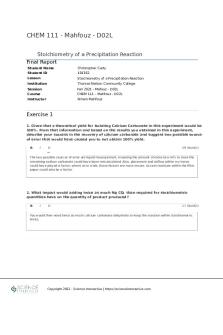Precipitation PDF

| Title | Precipitation |
|---|---|
| Course | Analytical Chemistry |
| Institution | Centro Escolar University |
| Pages | 1 |
| File Size | 40.8 KB |
| File Type | |
| Total Downloads | 266 |
| Total Views | 706 |
Summary
A. Define(a) digestion - the complex process of turning the food you eat into nutrients, which the body uses for energy, growth and cell repair needed to survive.(b) adsorption - the adhesion of atoms, ions or molecules from a gas, liquid or dissolved solid to a surface.(c) reprecipitation - after r...
Description
A. Define (a) digestion - the complex process of turning the food you eat into nutrients, which the body uses for energy, growth and cell repair needed to survive. (b) adsorption - the adhesion of atoms, ions or molecules from a gas, liquid or dissolved solid to a surface. (c) reprecipitation - after returning a precipitate to a dissolved state, the process of precipitating it again. (d) precipitation from homogeneous solution - if a precipitating agent is produced over a long period of time in a homogeneous solution the level of supersaturation remains low and compact crystal precipitates usually result instead of coagulated colloids. (e) counter-ion layer - contains sufficient excess of negative ions (principally nitrate) to just balance the charge on the surface of the particle. (f) mother liquor - the solution remaining after a component has been removed by some process such as filtration or more commonly, crystallization. (g) supersaturation - occurs with a chemical solution when the concentration of a solute exceeds the concentration specified by the value equilibrium solubility.
B. Explain the difference between (a) a colloidal and a crystalline precipitate - colloidal precipitates do not form easily and are difficult to be obtained via filtering whereas crystalline precipitates are easily formed and are easily obtained via filtering. (b) peptization and coagulation of a colloid - peptization is the formation of a colloidal dispersion from a precipitation while coagulation is the formation of aggregates from oppositely charged particles which are then settled down under gravity. (c) occlusion and mixed-crystal formation - mixed-crystal formation may occur in both colloidal and crystalline precipitates, but occlusion and mechanical entrapment are confined to crystalline precipitates. (d) nucleation and particle growth - nucleation is the formation of a new structure whereas particle growth is the process of increasing the size of a pre-existing structure....
Similar Free PDFs

Precipitation
- 1 Pages

precipitation titration.docx
- 12 Pages

Victim Precipitation theory
- 2 Pages

Precipitation Reactions Lab
- 5 Pages

Precipitation TEST WORD
- 3 Pages

Moisture, Clouds, Precipitation
- 3 Pages
Popular Institutions
- Tinajero National High School - Annex
- Politeknik Caltex Riau
- Yokohama City University
- SGT University
- University of Al-Qadisiyah
- Divine Word College of Vigan
- Techniek College Rotterdam
- Universidade de Santiago
- Universiti Teknologi MARA Cawangan Johor Kampus Pasir Gudang
- Poltekkes Kemenkes Yogyakarta
- Baguio City National High School
- Colegio san marcos
- preparatoria uno
- Centro de Bachillerato Tecnológico Industrial y de Servicios No. 107
- Dalian Maritime University
- Quang Trung Secondary School
- Colegio Tecnológico en Informática
- Corporación Regional de Educación Superior
- Grupo CEDVA
- Dar Al Uloom University
- Centro de Estudios Preuniversitarios de la Universidad Nacional de Ingeniería
- 上智大学
- Aakash International School, Nuna Majara
- San Felipe Neri Catholic School
- Kang Chiao International School - New Taipei City
- Misamis Occidental National High School
- Institución Educativa Escuela Normal Juan Ladrilleros
- Kolehiyo ng Pantukan
- Batanes State College
- Instituto Continental
- Sekolah Menengah Kejuruan Kesehatan Kaltara (Tarakan)
- Colegio de La Inmaculada Concepcion - Cebu









